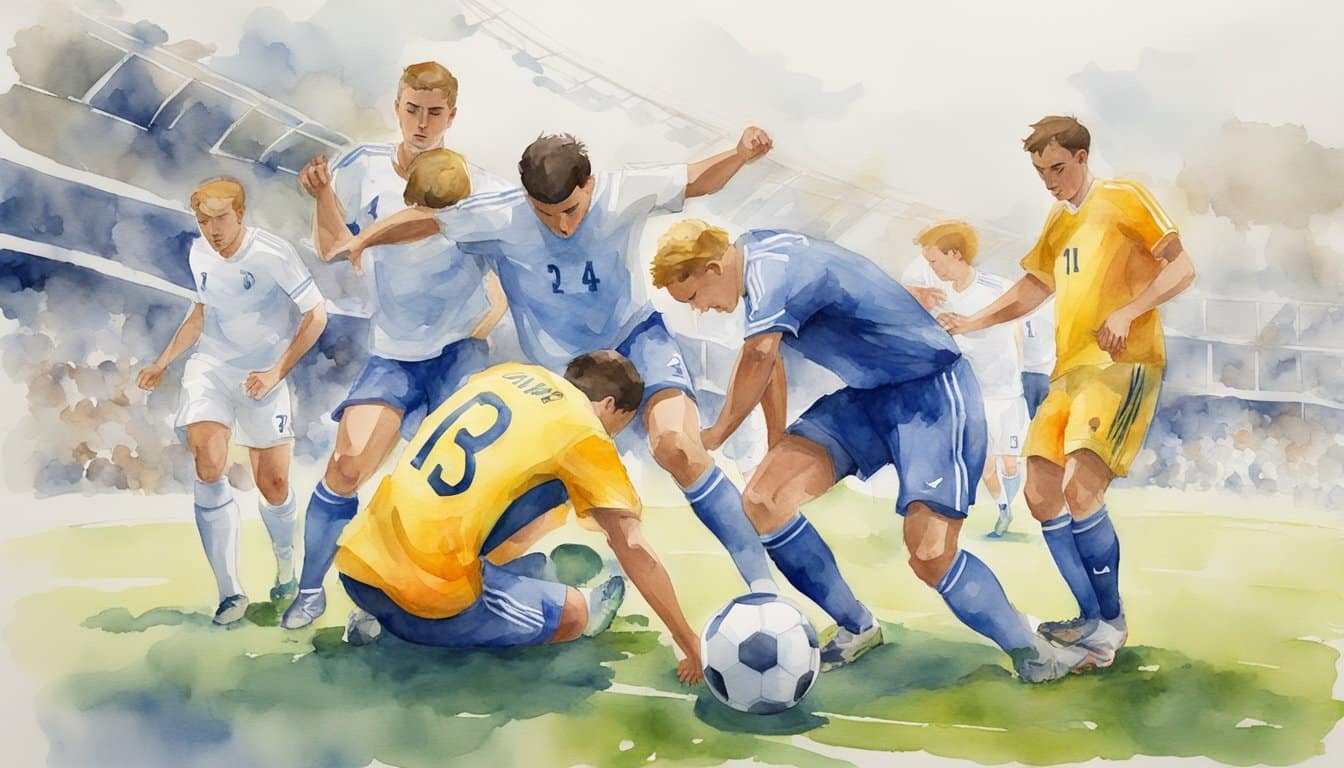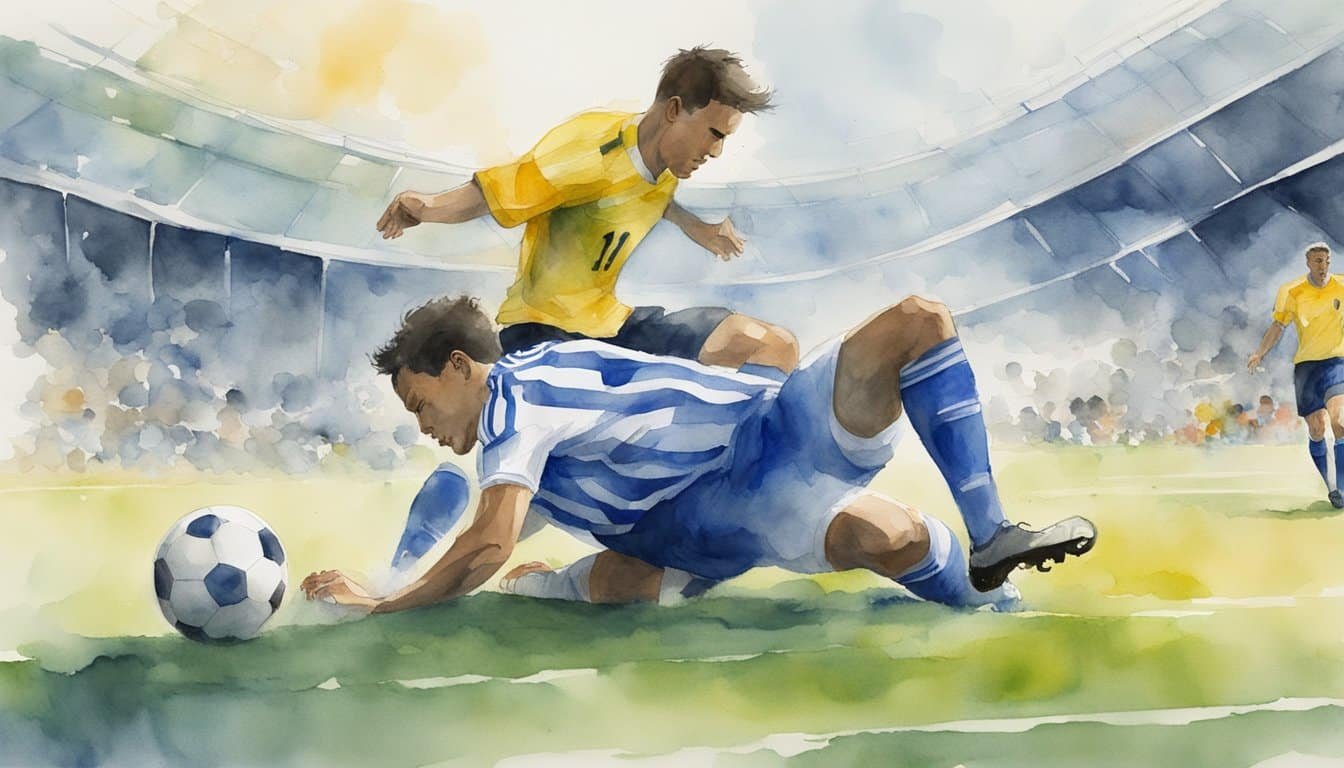Understanding Soccer Concussions
Soccer concussions are a type of traumatic brain injury that is increasingly gaining attention due to the sport’s popularity. Understanding the essentials, recognizing symptoms, and appreciating the prevalence in soccer helps to mitigate the risks involved.
Concussion Basics
A concussion is a type of traumatic brain injury that occurs when a blow or jolt to the head causes the brain to move rapidly inside the skull. This can lead to a variety of physical, cognitive, and emotional symptoms. It’s a complex condition that can occur even without a loss of consciousness. In soccer, concussions can result from collisions with other players, the ground, or the ball itself.
Diagnosis and Symptoms
Identifying a concussion involves a careful evaluation by medical professionals. Players suspected of having a concussion should be removed from play to minimize further injury. Concussion symptoms can include headache, dizziness, confusion, or even temporary memory loss. Notably, some symptoms may appear immediately, while others may develop over time.
Prevalence in Soccer
Soccer concussions are of particular concern because of the sport’s high impact nature and the frequent use of head to control and advance the ball. While soccer concussions might not be as high-profile as those in American football or boxing, they’re a significant issue. It’s important to understand the signs and symptoms of concussion so that players can be treated promptly.
- Concussions in soccer: a current understanding
- Concussion in soccer: a comprehensive review of the literature
- Concussions and heading in soccer: a review of the evidence
- Management of concussion in soccer
- Soccer-related concussions among Swedish elite soccer players
Prevention and Management

In the world of soccer, preventing concussions is just as crucial as effectively managing them after they occur. Carefully crafted strategies and specific gear can play a significant role in safeguarding players.
Preventative Measures
Heading the ball is a common part of soccer, yet it can also increase the risk of head injuries. Training players on proper technique and limiting head impact exposure during practice are key strategies in reducing soccer-related concussions. Moreover, increasing concussion awareness among players, coaches, and officials contributes to a safer playing environment, ensuring that everyone can recognize symptoms and understands the seriousness of head injuries.
An informed approach led by team physicians and experts in sports medicine includes educating individuals on the signs of concussion and enforcing mandatory rest periods after a suspected head injury. Quick identification and response can limit the severity and improve recovery times.
Concussion Management
Following a concussion, standard practice entails a period of rest followed by a gradual return to play. It’s essential to monitor symptoms and cognitive function closely to avoid rapid return, which can exacerbate the injury. Monitoring steps often involve objective testing methods to assess neurological deficits and guide the recovery process. The doctor plays a pivotal role, often in coordination with specialized concussion management teams to tailor individualized recovery plans for players.
Recovery protocols typically reflect the latest clinical guidelines and focus on a symptom-limited activity which means patients increase their activity levels without exacerbating symptoms. The goal is to prevent long-term impacts such as chronic traumatic encephalopathy, a condition found in athletes with repeated concussions.
Role of Protective Gear
The efficacy of protective headgear in soccer has been debated. While some studies suggest that headgear might reduce head acceleration during impact, there’s a scarcity of reliable evidence to support widespread use for concussion prevention. Still, for those recovering from the head injury or in youth sports settings, utilizing headgear as an additional safety measure can be considered.
Understanding the limitations and appropriate use of safety equipment like helmets and mouth guards is essential. These pieces of equipment may provide some benefit, but they are not substitutes for proper training and adherence to safety protocols in the prevention and management of soccer injuries.
Implications and Regulations

Soccer’s popularity comes with a responsibility to address the risks associated with concussions, spurring regulations and changes in both culture and research efforts.
Legal and Regulatory Considerations
Within the United States, the legal landscape surrounding concussions in youth soccer has tightened, with FIFA and other governing bodies facing pressure to enhance player safety. Legal consciousness varies across the globe, as indicated by a study on U.S. and Scotland youth soccer coaches. Legal frameworks aim to protect players, especially at the youth level, by mandating clear concussion protocols.
Soccer Culture and Education
Education is pivotal in shifting soccer culture towards recognizing and addressing soccer-related injuries. Initiatives like the elimination of heading in players under 10 may contribute to reducing concussion risks. Programs targeting a range of stakeholders, from youth soccer to professional soccer players, emphasize the importance of recognizing injury mechanisms and promote a safer approach to the contact sport.
Research and Future Directions
PLOS One and similar journals reflect a growing body of research that informs future directions for the sport. Studies compare soccer players with histories of concussion to those without, providing insights that influence regulatory changes. As the NCAA and other organizations invest in research, the long-term implications of concussions are becoming clearer, informing both upcoming World Cup protocols and women’s soccer guidelines.

